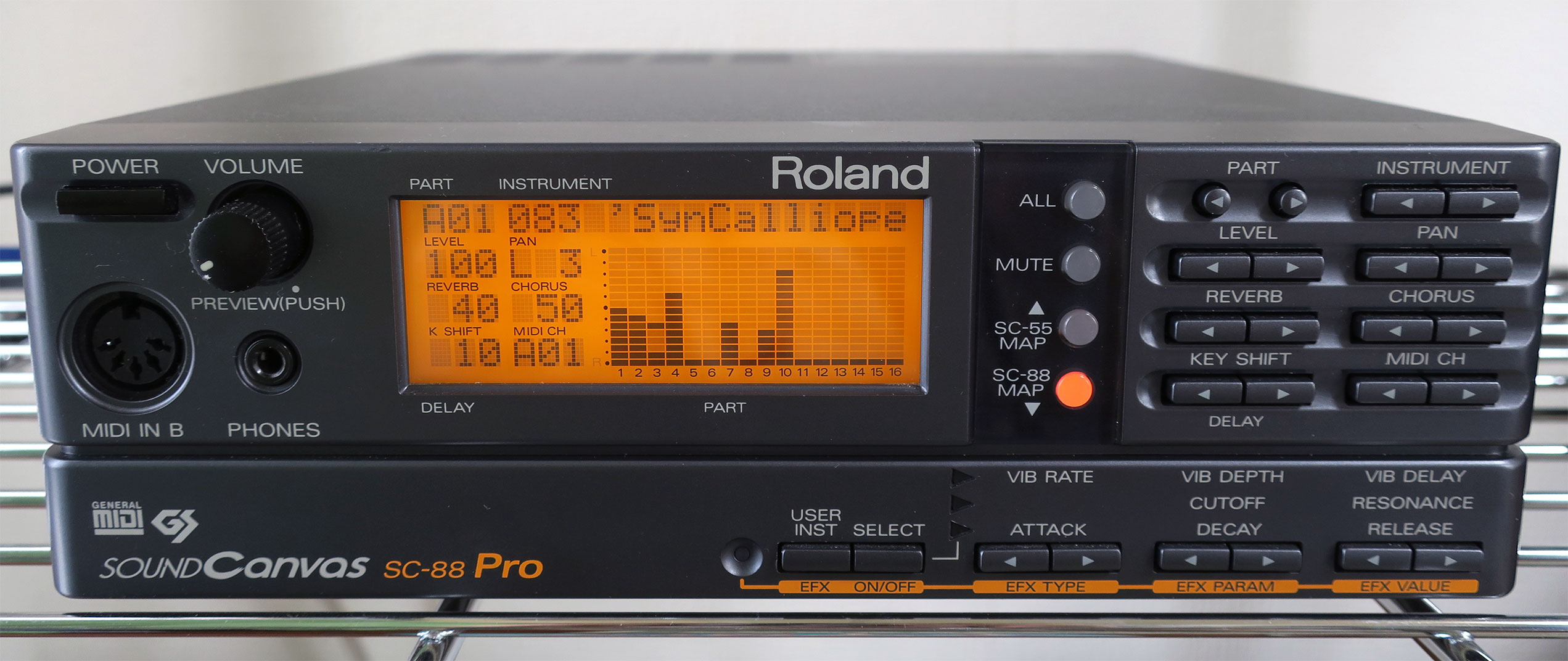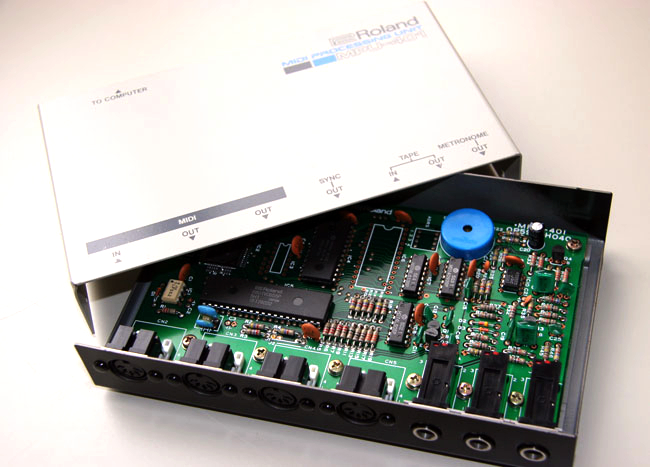|
SC-55
The Roland SC-55 ( Sound Canvas) is a GS MIDI sound module released in 1991 by Roland. The SC-55 was the first sound module to incorporate the new General MIDI standard. It was the first in the Roland Sound Canvas series. The SC-55 used both PCM and a cut-down version of the LA synthesis engine, to support 24-voice polyphony with 16-part multitimbrality. It came preloaded with the Roland MT-32's variation bank, but lacked the MT-32's re-programmability. Aimed at PC music enthusiasts, the SC-55 featured 317 instrument patches, including the GS drum kits and additional controllers. The selection of effects includes reverb and chorus. Alongside the SC-55, Roland released the SB-55 (Sound Brush), an inexpensive MIDI sequencer module the same size as the Sound Canvas. Both the Sound Canvas and Sound Brush could be rackmounted alongside each other. Other models with comparable tone generators include Roland CM-300, Roland CM-500 and Roland SC-155 sound modules. CM-300 and CM-500 ... [...More Info...] [...Related Items...] OR: [Wikipedia] [Google] [Baidu] |
Roland Sound Canvas
Roland/Edirol Sound Canvas lineup is a series of General MIDI (GM) based pulse-code modulation (PCM) sound modules and sound cards, primarily intended for computer music usage, created by Japanese manufacturer Roland Corporation. Some models include a serial or USB connection, to a personal computer. Products Sound Canvas In some cases also sold as "Edirol" rather than "Roland" as the brand name. Sound Canvas Personal Computer Products Computer Music Products Sound Canvas and Keyboard The following combine a sound canvas module with a built in MIDI keyboard Edirol Roland sold GM/GS products under its Edirol brand. The samples contained in the ROMs of these units do not in all cases mirror the original SC-7 / SC-55 GM/GS samples. GM2 is downward compatible with GM. The SD line was also sold under the "Roland" brand. Virtual Sound Canvas There is also the VSC, Virtual Sound Canvas, range of PC software which provide GM and GS synthesis on Windows PCs. Many ver ... [...More Info...] [...Related Items...] OR: [Wikipedia] [Google] [Baidu] |
Roland SCC-1
The Roland SC-55 ( Sound Canvas) is a GS MIDI sound module released in 1991 by Roland. The SC-55 was the first sound module to incorporate the new General MIDI standard. It was the first in the Roland Sound Canvas series. The SC-55 used both PCM and a cut-down version of the LA synthesis engine, to support 24-voice polyphony with 16-part multitimbrality. It came preloaded with the Roland MT-32's variation bank, but lacked the MT-32's re-programmability. Aimed at PC music enthusiasts, the SC-55 featured 317 instrument patches, including the GS drum kits and additional controllers. The selection of effects includes reverb and chorus. Alongside the SC-55, Roland released the SB-55 (Sound Brush), an inexpensive MIDI sequencer module the same size as the Sound Canvas. Both the Sound Canvas and Sound Brush could be rackmounted alongside each other. Other models with comparable tone generators include Roland CM-300, Roland CM-500 and Roland SC-155 sound modules. CM-300 and CM-50 ... [...More Info...] [...Related Items...] OR: [Wikipedia] [Google] [Baidu] |
Roland GS
Roland GS, or just GS, sometimes expanded as General Standard or General Sound, is a MIDI specification. It requires that all GS-compatible equipment must meet a certain set of features and it documents interpretations of some MIDI commands and bytes sequences, thus defining instrument tones, controllers for sound effects, etc. In addition to the simpler General MIDI standard, GS defines 98 additional tone instruments, 15 more percussion instruments, 8 more drum kits, 3 effects (reverb/chorus/variation) and some other features. The Roland SC-55 was the first synthesizer to support the GS standard. History The GS extensions were first introduced and implemented on Roland Sound Canvas series modules, starting with the Roland SC-55 in 1991. The first model supported 317 instruments, 16 simultaneous melodic voices, 8 percussion voices and a compatibility mode for Roland MT-32 (although it only emulated it and lacked programmability of original MT-32) and gained explosive popularit ... [...More Info...] [...Related Items...] OR: [Wikipedia] [Google] [Baidu] |
MPU-401
The MPU-401, where ''MPU'' stands for MIDI Processing Unit, is an important but now obsolete interface for connecting MIDI-equipped electronic music hardware to personal computers. It was designed by Roland Corporation, which also co-authored the MIDI standard. Design Released around 1984, the original MPU-401 was an external breakout box providing MIDI IN/MIDI OUT/MIDI THRU/TAPE IN/TAPE OUT/MIDI SYNC connectors, for use with a separately-sold interface card/cartridge ("MPU-401 interface kit") inserted into a computer system. For this setup, the following "interface kits" were made: * MIF-APL: For the Apple II. * MIF-C64: For the Commodore 64. * MIF-FM7: For the Fujitsu FM7. * MIF-IPC: For the IBM PC/IBM XT. It turned out not to work reliably with 286 and faster processors. Early versions of the actual PCB had IF-MIDI/IBM as a silk screen. * MIF-IPC-A: For the IBM AT, works with PC and XT as well. * Xanadu MUSICOM IFM-PC: For the IBM PC / IBM XT / IBM AT. This was a third party ... [...More Info...] [...Related Items...] OR: [Wikipedia] [Google] [Baidu] |
Roland MT-32
The Roland MT-32 Multi-Timbre Sound Module is a MIDI synthesizer module first released in 1987 by Roland Corporation. It was originally marketed to amateur musicians as a budget external synthesizer with an original list price of $695. However, it became more famous along with its compatible modules as an early ''de facto'' standard in computer music. Since it was made prior to the release of the General MIDI standard, it uses its own proprietary format for MIDI file playback. Within Roland's family of Linear Arithmetic (LA) synthesizers, the multitimbral MT-32 series constitutes the budget prosumer line for computer music at home, the multitimbral D-5, D-10, D-20 and D-110 models constitute the professional line for general studio use, and the high-end monotimbral D-50 and D-550 models are for sophisticated multi-track studio work. It was the first product in Roland's line of Desktop Music System (DTM) packages in Japan. Features Like the Roland D-50 Linear Synthesizer, ... [...More Info...] [...Related Items...] OR: [Wikipedia] [Google] [Baidu] |
Roland SC-8850
The Roland ED SC-8850 ( Sound Canvas) is a GS-compatible MIDI sound module released in 1999 by Roland under the name RolandED. The SC-8850 was the first sound module to incorporate the new General MIDI Level 2 standard. The SC-8850 uses a PCM sampling engine based on that of the SC-88 Pro, and supports 128-voice polyphony with 64-part multitimbrality. It came preloaded with the soundsets of all older Sound Canvas models, as well as the CM-32 and MT-32. Aimed at personal computer users, the SC-8850 features 1,703 instrument patches, including the GS sounds and additional GM2 sounds. The selection of effects includes reverb, chorus, and Roland's own Insertion EFX, which adds effects like vibrato, distortion, tremolo, etc. SC-8820 Alongside the SC-8850, Roland released the Roland ED SC-8820, an inexpensive cut-down version of the MIDI module, smaller than the 8850. Both SC-8850 and ED SC-8820 could be rackmounted alongside each other. The Roland SC-8820 model lacks the large LCD s ... [...More Info...] [...Related Items...] OR: [Wikipedia] [Google] [Baidu] |
Space Quest III
''Space Quest III: The Pirates of Pestulon'' is a 1989 graphic adventure game by Sierra On-Line, and the third game in the ''Space Quest'' series. Plot Roger Wilco's escape pod from the end of ''Space Quest II'' is floating in space until it is picked up by an automated garbage freighter. Finding a derelict spaceship amongst the freighter's garbage, Roger sets out to repair the ''Aluminum Mallard'' and leave the scow. Roger visits a variety of locations, including a fast food restaurant called Monolith Burger and a desert planet called Phleebhut. At the latter, he encounters trouble, as ''Arnoid the Annihilator'' (an Arnold Schwarzenegger-like android terminator) persecutes him for not paying for a whistle acquired in ''Space Quest II''. From information he picks up there and at Monolith Burger, Roger eventually uncovers the sinister activities of a video game company known as ScumSoft, run by the "Pirates of Pestulon". Pestulon, a small moon of the volcanic planet Ortega, i ... [...More Info...] [...Related Items...] OR: [Wikipedia] [Google] [Baidu] |
SysEx
MIDI (; Musical Instrument Digital Interface) is a technical standard that describes a communications protocol, Digital electronics, digital interface, and electrical connectors that connect a wide variety of electronic musical instruments, computers, and related audio devices for playing, editing, and recording music. The specification originates in the paper ''Universal Synthesizer Interface'' published by Dave Smith (engineer), Dave Smith and Chet Wood of Sequential (company), Sequential Circuits at the 1981 Audio Engineering Society conference in New York City. A single MIDI cable can carry up to sixteen channels of MIDI data, each of which can be routed to a separate device. Each interaction with a key, button, knob or slider is converted into a MIDI event, which specifies musical instructions, such as a note's Pitch (music), pitch, timing and Dynamics (music), loudness. One common MIDI application is to play a MIDI Electronic keyboard, keyboard or other controller an ... [...More Info...] [...Related Items...] OR: [Wikipedia] [Google] [Baidu] |


